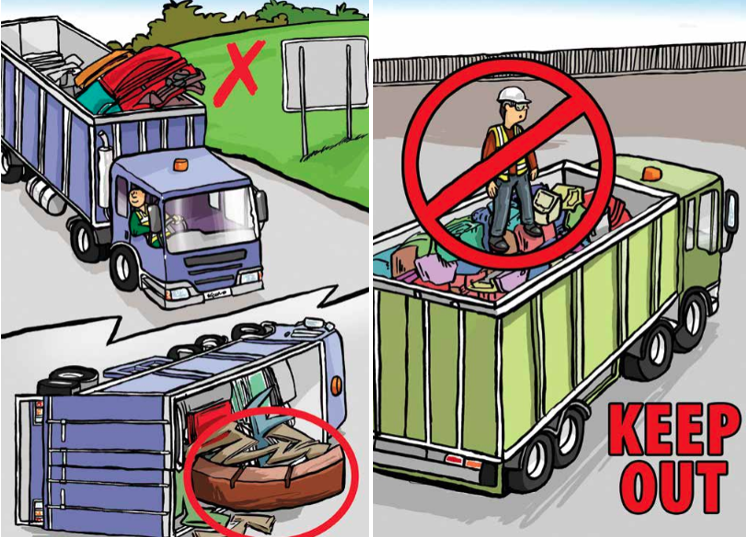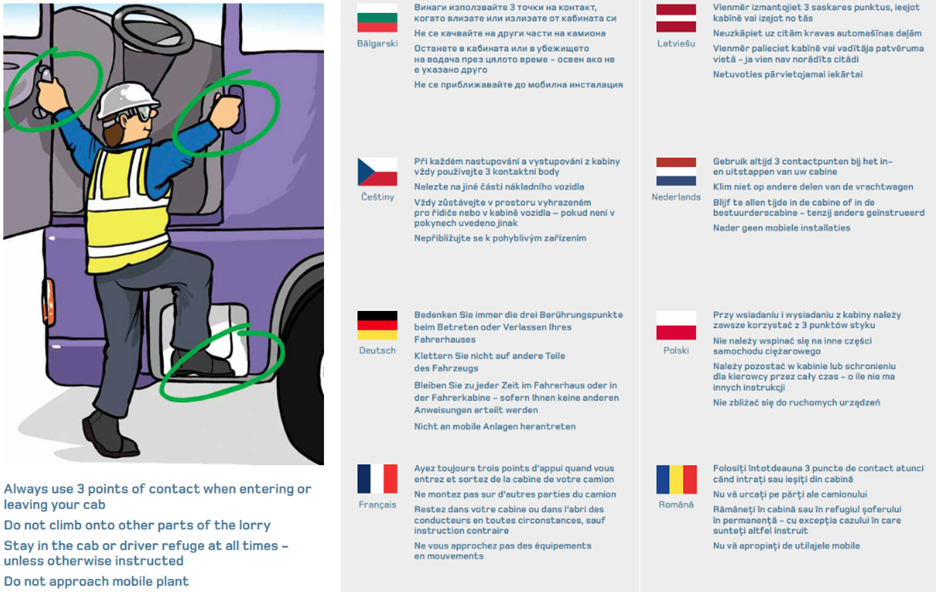NEWS
Best practice: port to haulier information
Campaigns |Published: Dec 3, 2024

By enhancing communications with hauliers, ports can improve safety for all users. This latest article for the Port to Haulier campaign, discusses some ways in which ports can enhance communication and safety for hauliers.
The most effective safety protocols use visual-focused methods, such as pictograms and diagrams, to ensure quick understanding in high-traffic environments. Regular feedback and updates keep resources relevant, aligning with hauliers’ real-world needs.
Clear visual communication
Use concise text and visuals, with minimal reliance on voiceovers, to ensure accessibility in noisy port environments and rapid comprehension by hauliers. A pictogram with minimal text is more likely to be observed than a text heavy infographic or detailed information chart – particularly when the target audience may be in motion.

Source: SIMS Metal – visiting driver site safety
To aid clear visual communication between ports and hauliers, ports can use signage, maps, and video guides that provide step-by-step instructions in easily understandable formats. Additionally, using visual aids like mobile signs and route markers ensures that drivers remain on the right path while enhancing safety. These methods bridge the communication gap, ensuring both clarity and safety in high-traffic environments.
Multilingual support
Provide critical safety and process information in multiple languages (e.g., English, Hungarian, Lithuanian, Polish, Romanian) to cater to diverse haulier backgrounds. By providing translated versions of signage, instructional videos, and other materials such as brochures and maps, ports can aid communication with hauliers who have English as a second language.

Source: SIMS Metal – visiting driver site safety
Digital tools like apps or websites often have language options built in which can provide real-time updates in a variety of languages. Regular training and multilingual customer service can also further enhance communication. Apps can feature alerts, navigational guidance, and access to port rules, ensuring that hauliers have up-to-date information at their fingertips, improving efficiency and safety throughout their visit.
An example of this is Hutchison Ports’ UBI app, which enables hauliers to access live updates and safety information, regardless of their location within the port.
Orientation and navigation
Video walkthrough guides from the driver’s perspective are an easy way to guide hauliers through the port in advance of arrival, and show them where to go if they have not visited before. Videos filmed from the cab, show the driver’s perspective of the port, guiding them through container areas, trailer zones, and docking procedures.
These videos can highlight key routes and obstacles, helping drivers understand the layout of the port. Additionally, digital maps, clear signage, and well-marked lanes further enhance guidance, while designated areas for specific tasks (like trailer adjustments) reduce confusion and improve safety.
Safety standards
Highlight essential safety information with a clear focus on visuals and minimal text, ensuring hauliers understand safety protocols quickly. Ports can support hauliers with safety standards by using simple, visual-focused methods like clear signage, symbols, and diagrams to highlight key safety protocols.
These materials should feature minimal text to ensure quick comprehension, especially in high-traffic or noisy areas. Safety information can also be delivered through video guides, mobile apps, and on-site displays, ensuring that drivers are fully aware of safety measures like speed limits, pedestrian zones, and equipment use, promoting a safer environment for all workers and hauliers.
Continuous engagement and review
Encourage feedback on induction videos and review resources regularly to keep content updated and relevant, addressing any changes such as altered road layouts and any recurring issues hauliers may face. This feedback helps identify areas for improvement and keep content updated.
Regular communication channels, like surveys or app notifications, can be used to gather insights and make adjustments. This ensures that safety training and resources remain relevant, effective, and aligned with the real-world experiences of hauliers, contributing to ongoing safety improvements.
Resources
Hutchison Ports UBI app – enhancing digital accessibility
Hutchison Ports’ UBI app offers a great example of how ports can enhance digital accessibility for hauliers. The app enables drivers to access live updates, safety information, and navigational guidance, which is essential for improving operational efficiency and safety.
Hutchison Ports UBI App
Transport for London (TfL) – multilingual support for drivers
Transport for London’s multilingual support initiatives provide an example of how clear, concise, and accessible information can be made available in multiple languages, helping drivers from different backgrounds understand operational procedures.
Transport for London – Multilingual Resources
SIMS Metal – visiting driver safety
This document is issued to drivers visiting site and can be used as an example of best practice.
